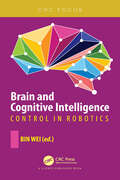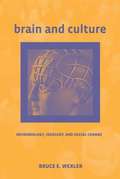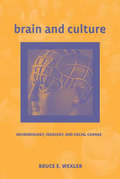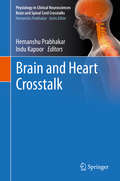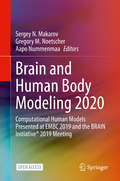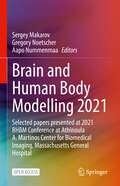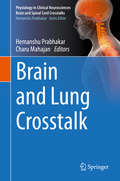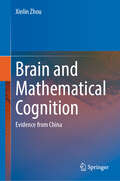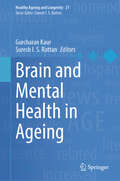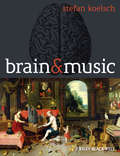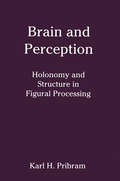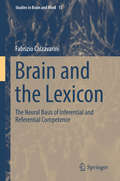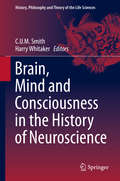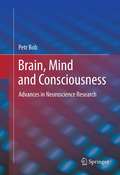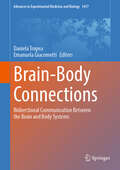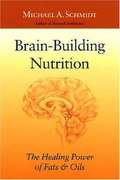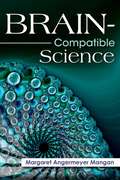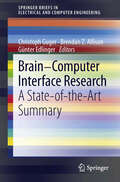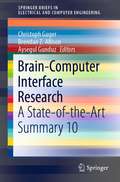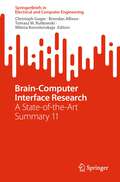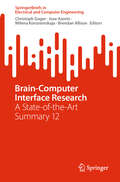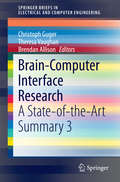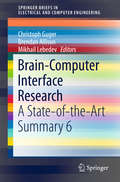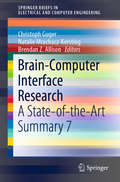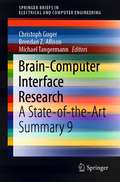- Table View
- List View
Brain and Cognitive Intelligence: Control in Robotics
by Bin WeiThe aim of the book is to introduce the state-of-the-art technologies in the field of brain and cognitive intelligence used in robotics control, particularly on studying how the brain learns and controls complex motor skills and how to replicate these in robots. This will be the first book that systematically and thoroughly deals with the above topics. Advances made in the past decades are described. Interesting topics such as human-robot interactions, neurorobotics, biomechanics in robotic control, robot vision, force control, and control and coordination of humanoid robots are covered.
Brain and Culture: Neurobiology, Ideology, and Social Change
by Bruce E. WexlerChoice Outstanding Academic Title, 2007. Research shows that between birth and early adulthood the brain requires sensory stimulation to develop physically. The nature of the stimulation shapes the connections among neurons that create the neuronal networks necessary for thought and behavior. By changing the cultural environment, each generation shapes the brains of the next. By early adulthood, the neuroplasticity of the brain is greatly reduced, and this leads to a fundamental shift in the relationship between the individual and the environment: during the first part of life, the brain and mind shape themselves to the major recurring features of their environment; by early adulthood, the individual attempts to make the environment conform to the established internal structures of the brain and mind. In Brain and Culture, Bruce Wexler explores the social implications of the close and changing neurobiological relationship between the individual and the environment, with particular attention to the difficulties individuals face in adulthood when the environment changes beyond their ability to maintain the fit between existing internal structure and external reality. These difficulties are evident in bereavement, the meeting of different cultures, the experience of immigrants (in which children of immigrant families are more successful than their parents at the necessary internal transformations), and the phenomenon of interethnic violence. Integrating recent neurobiological research with major experimental findings in cognitive and developmental psychology--with illuminating references to psychoanalysis, literature, anthropology, history, and politics--Wexler presents a wealth of detail to support his arguments. The groundbreaking connections he makes allow for reconceptualization of the effect of cultural change on the brain and provide a new biological base from which to consider such social issues as "culture wars" and ethnic violence.
Brain and Culture: Neurobiology, Ideology, and Social Change (Bradford Bks.)
by Bruce E. WexlerResearch shows that between birth and early adulthood the brain requires sensory stimulation to develop physically. The nature of the stimulation shapes the connections among neurons that create the neuronal networks necessary for thought and behavior. By changing the cultural environment, each generation shapes the brains of the next. By early adulthood, the neuroplasticity of the brain is greatly reduced, and this leads to a fundamental shift in the relationship between the individual and the environment: during the first part of life, the brain and mind shape themselves to the major recurring features of their environment; by early adulthood, the individual attempts to make the environment conform to the established internal structures of the brain and mind. In Brain and Culture, Bruce Wexler explores the social implications of the close and changing neurobiological relationship between the individual and the environment, with particular attention to the difficulties individuals face in adulthood when the environment changes beyond their ability to maintain the fit between existing internal structure and external reality. These difficulties are evident in bereavement, the meeting of different cultures, the experience of immigrants (in which children of immigrant families are more successful than their parents at the necessary internal transformations), and the phenomenon of interethnic violence. Integrating recent neurobiological research with major experimental findings in cognitive and developmental psychology—with illuminating references to psychoanalysis, literature, anthropology, history, and politics—Wexler presents a wealth of detail to support his arguments. The groundbreaking connections he makes allow for reconceptualization of the effect of cultural change on the brain and provide a new biological base from which to consider such social issues as "culture wars" and ethnic violence.
Brain and Heart Crosstalk (Physiology in Clinical Neurosciences – Brain and Spinal Cord Crosstalks)
by Hemanshu Prabhakar Indu KapoorThis book discusses the underlying mechanisms connecting the brain and heart. The physiology of the brain is such that it is easily affected by any altered physiology of other systems, which in turn may compromise cerebral blood flow and oxygenation. Together, the brain and heart control our body systems, allowing them to function automatically. This interaction between the brain and other systems makes it important for us to understand how any kind of injury to the brain can produce complications in remote organs or systems, such as the heart. The central nervous system is responsible for vegetative function and is central to homeostasis. Further, central nervous system responses are linked to the ongoing function of other organ systems e.g. feeding, thermoregulation, reproduction and muscle activity. It is therefore logical that neural control of the cardiovascular system must also interact with the neural control of other organ systems. This book explains in detail stressed cardiac conditions, discussing the pathophysiology and proposed treatment, and also describing lesser-known crosstalks between the acutely or chronically affected brain and heart.
Brain and Human Body Modeling 2020: Computational Human Models Presented at EMBC 2019 and the BRAIN Initiative® 2019 Meeting
by Gregory M. Noetscher Sergey N. Makarov Aapo NummenmaaThis open access book describes modern applications of computational human modeling in an effort to advance neurology, cancer treatment, and radio-frequency studies including regulatory, safety, and wireless communication fields. Readers working on any application that may expose human subjects to electromagnetic radiation will benefit from this book’s coverage of the latest models and techniques available to assess a given technology’s safety and efficacy in a timely and efficient manner.Describes computational human body phantom construction and application;Explains new practices in computational human body modeling for electromagnetic safety and exposure evaluations;Includes a survey of modern applications for which computational human phantoms are critical.
Brain and Human Body Modelling 2021: Selected papers presented at 2021 BHBM Conference at Athinoula A. Martinos Center for Biomedical Imaging, Massachusetts General Hospital
by Sergey Makarov Gregory Noetscher Aapo NummenmaaThis open access book describes modern applications of computational human modelling to advance neurology, cancer treatment, and radio-frequency studies including regulatory, safety, and wireless communication fields. Readers working on any application that may expose human subjects to electromagnetic radiation will benefit from this book’s coverage of the latest models and techniques available to assess a given technology’s safety and efficacy in a timely and efficient manner.This is an Open Access book.
Brain and Lung Crosstalk (Physiology in Clinical Neurosciences – Brain and Spinal Cord Crosstalks)
by Hemanshu Prabhakar Charu MahajanThe central nervous system, which includes the brain and spinal cord, has a high metabolic demand. The physiology of the brain is such that it is easily affected by alterations in other systems, which in turn can compromise cerebral blood flow and oxygenation. Together the brain and spinal cord control the automatic function of our body systems. While other systems of body controls individual functions, central nervous system at the same time does many different functions, especially, controlling the function of other systems. This interaction between the brain and other systems is important when it comes to understanding how injuries to the brain can, at times, produce complications in remote organs or systems of the body, such as the lungs. This book explains the lesser-known crosstalks between acutely or chronically affected brain and lung, describing the pathophysiology of the lung following brain injury and discussing in detail the conflicts between the brain and lungs in relation to the tidal volumes, positive end-expiratory pressures, arterial carbon dioxide and oxygen levels, recruitment maneuvers and positioning, as well as potential therapeutic targets.
Brain and Mathematical Cognition: Evidence from China
by Xinlin ZhouThis book intends to present a series of insights coming from in-depth investigation of brain and mathematical cognition in Chinese population. Specifically, the book introduces research on the associations among number sense, visual form perception and mathematical fluency; symbolic and non-symbolic mental number line; and the role of spatial modeling and logical inference in mathematical problem solving. The book summarizes author's previous studies on the involvement of semantic network other than visuospatial network in mathematical cognition. The three-component mathematical model that comes out of more than 10 years of research on mathematical cognition is introduced. The book presents the effect of learning experience on arithmetic-related brain system. Chinese abacus that can be used to eradicate developmental dyscalculia in classroom is briefly discussed. Special attention in this book is paid to mathematical anxiety and mathematical learning disorders in Chinese schoolchildren. Finally, gender differences in mathematical cognition are also reviewed.
Brain and Mental Health in Ageing (Healthy Ageing and Longevity #21)
by Suresh I. S. Rattan Gurcharan KaurThis volume in the book series Healthy Ageing and Longevity focuses on the interaction and co-dependence of the brain and mental health during ageing. A wide-range of topics discussed here include conceptual and historical understanding, descriptive analyses, and evidence-based interventions for the maintenance, enhancement and recovery of the brain and mental health, especially in old age. The emphasis is on the effective biological and psycho-social lifestyle factors, and complementary medicine and traditional cultural practices that could be health beneficial. Potential readership includes the early stage- and experienced researchers in biogerontology and cognitive sciences, and college/university teachers, medical practitioners, health care personnel, and public educationists.
Brain and Music
by Stefan KoelschA comprehensive survey of the latest neuroscientific research into the effects of music on the brainCovers a variety of topics fundamental for music perception, including musical syntax, musical semantics, music and action, music and emotionIncludes general introductory chapters to engage a broad readership, as well as a wealth of detailed research material for expertsOffers the most empirical (and most systematic) work on the topics of neural correlates of musical syntax and musical semanticsIntegrates research from different domains (such as music, language, action and emotion both theoretically and empirically, to create a comprehensive theory of music psychology
Brain and Perception: Holonomy and Structure in Figural Processing (Distinguished Lecture Series)
by Karl H. PribramPresented as a series of lectures, this important volume achieves four major goals: 1) It integrates the results of the author's research as applied to pattern perception -- reviewing current brain research and showing how several lines of inquiry have been converging to produce a paradigm shift in our understanding of the neural basis of figural perception. 2) It updates the holographic hypothesis of brain function in perception. 3) It emphasizes the fact that both distributed (holistic) and localized (structural) processes characterize brain function. 4) It portrays a neural systems analysis of brain organization in figural perception by computational models -- describing processing in terms of formalisms found useful in ordering data in 20th-century physical and engineering sciences. The lectures are divided into three parts: a Prolegomenon outlining a theoretical framework for the presentation; Part I dealing with the configural aspects of perception; and Part II presenting its cognitive aspects. The appendices were developed in a collaborative effort by the author, Kunio Yasue, and Mari Jibu (both of Notre Dame Seishin University of Okayama, Japan).
Brain and the Lexicon: The Neural Basis of Inferential and Referential Competence (Studies in Brain and Mind #15)
by Fabrizio CalzavariniThis monograph offers a novel, neurocognitive theory concerning words and language. It explores the distinction between inferential and referential semantic competence. The former accounts for the relationship of words among themselves, the latter for the relationship of words to the world. The author discusses this distinction at the level of the human brain on both theoretical and neuroscientific grounds. In addition, this investigation considers the relation between the inf/ref neurocognitive theory and other accounts of semantic cognition proposed in the field of neurosemantics, as well as some potential implications of the theory for clinical neuroscience and the philosophy of semantics. Overall, the book offers an important contribution to the debate about lexical semantic competence. It combines a strong philosophical and linguistic background with a comprehensive and critical analysis of neurosemantic literature. Topics discussed lie at the intersection of philosophical semantics, linguistics, neurolinguistics, cognitive science, artificial intelligence, cognitive neuroscience, and clinical psychology. Due to its interdisciplinary orientation, coverage is rich in introductory remarks and not overly technical, therefore it is accessible to non-experts as well.
Brain, Mind and Consciousness in the History of Neuroscience (History, Philosophy and Theory of the Life Sciences #6)
by C. U. M. Smith Harry WhitakerThis volume of essays examines the problem of mind, looking at how the problem has appeared to neuroscientists (in the widest sense) from classical antiquity through to contemporary times. Beginning with a look at ventricular neuropsychology in antiquity, this book goes on to look at Spinozan ideas on the links between mind and body, Thomas Willis and the foundation of Neurology, Hooke's mechanical model of the mind and Joseph Priestley's approach to the mind-body problem. The volume offers a chapter on the 19th century Ottoman perspective on western thinking. Further chapters trace the work of nineteenth century scholars including George Henry Lewes, Herbert Spencer and Emil du Bois-Reymond. The book covers significant work from the twentieth century, including an examination of Alfred North Whitehead and the history of consciousness, and particular attention is given to the development of quantum consciousness. Chapters on slavery and the self and the development of an understanding of Dualism bring this examination up to date on the latest 21st century work in the field. At the heart of this book is the matter of how we define the problem of consciousness itself: has there been any progress in our understanding of the working of mind and brain? This work at the interface between science and the humanities will appeal to experts from across many fields who wish to develop their understanding of the problem of consciousness, including scholars of Neuroscience, Behavioural Science and the History of Science.
Brain, Mind and Consciousness: Advances in Neuroscience Research
by Petr BobNeuropsychological research on the neural basis of behavior generally asserts that brain mechanisms ultimately suffice to explain all psychologically described phenomena. This assumption stems from the idea that the brain consists entirely of material particles and fields, and that all causal mechanisms relevant to neuroscience can be formulated solely in terms of properties of these elements. Contemporary basic physical theory differs from classic physics on the important matter of how consciousness of human agents enters into the structure of empirical phenomena. The new principles contradict the older idea that local mechanical processes alone account for the structure of all empirical data. Contemporary physical theory brings directly into the overall causal structure certain psychologically described choices made by human agents about how they will act. This key development in basic physical theory is applicable to neuroscience. This book explores this new framework.
Brain-Body Connections: Bidirectional Communication Between the Brain and Body Systems (Advances in Experimental Medicine and Biology #1477)
by Daniela Tropea Emanuela GiacomettiThis book offers a broad exploration of the intricate networks that facilitate communication between the brain and various systems in the body. At the heart of this volume is the examination of how these connections influence both physiological and pathological outcomes. The first two chapters of the book describe the Blood Brain Barrier (BBB) and the interaction of the brain with the peripheral nervous system. The following chapters delve into the reciprocal communication of the brain and the circulatory, immune, metabolic and digestive systems and discuss the impact of these communication mechanisms on human health and disease. Contributions from leading experts provide a detailed analysis of these complex interactions, making this book a must-read for anyone interested in the molecular underpinnings of brain-body communication. Researchers, scholars, and students in neuroscience, physiology, and related fields will find this book invaluable. It not only enhances understanding of the brain's role in regulating bodily functions but also offers insights into potential therapeutic targets for various disorders. This volume is an essential addition to any scientific library.
Brain-Building Nutrition: How Dietary Fats and Oils Affect Mental, Physical, and Emotional Intelligence
by Michael SchmidtThis provides a host of practical dietary information and new, groundbreaking research to support the author's findings. A remarkable but little known fact is that the brain is nearly 60 percent fat.
Brain-Compatible Science
by Margaret Angermeyer ManganGain fresh insights for teaching, learning, and assessing knowledge of critical science concepts through the exploration of research-based practices for science education.
Brain-Computer Interface Research: A State-of-the-Art Summary (SpringerBriefs in Electrical and Computer Engineering #6)
by Brendan Z. Allison Christoph Guger Günter EdlingerBrain-computer interfaces (BCIs) are rapidly developing into a mainstream, worldwide research endeavor. With so many new groups and projects, it can be difficult to identify the best ones. This book summarizes ten leading projects from around the world. About 60 submissions were received in 2011 for the highly competitive BCI Research Award, and an international jury selected the top ten. This Brief gives a concise but carefully illustrated and fully up-to-date description of each of these projects, together with an introduction and concluding chapter by the editors.
Brain-Computer Interface Research: A State-of-the-Art Summary 10 (SpringerBriefs in Electrical and Computer Engineering)
by Brendan Z. Allison Christoph Guger Aysegul GunduzThe Annual BCI Research Awards are international prizes that recognize the top new projects in brain–computer interface (BCI) research. This book contains concise descriptions of projects nominated for the 2020 BCI Research Award and interviews with nominees. Each article is authored by the researchers who developed the project, and articles have been updated with new progress achieved since their nomination. These chapters are complemented by an introduction by the editors together with a concluding chapter that reviews the annual Awards Ceremony, announces the winners, and ends with a brief discussion.One of the prominent trends in recent years has been the development of BCIs for restoring limb use and for aiding optical and auditory sensory perception. Many chapters in this book present emerging and novel research directions likely to become more prevalent in the near future. This year's book includes chapters based on interviews with BCI experts who were nominated for an award, including this year's first, second, and third place winners. These interview chapters are generally less technical than project descriptions, and provide individual perspectives from people actively working on new methods and systems.
Brain-Computer Interface Research: A State-of-the-Art Summary 11 (SpringerBriefs in Electrical and Computer Engineering)
by Brendan Allison Christoph Guger Tomasz M. Rutkowski Milena KorostenskajaThis book showcases recent trends in brain-computer interface development. It highlights fascinating results in areas such as language decoding, spinal cord stimulation to enable gait and to restore hand functions. The contributions are based on the 12 nominated brain-computer interface projects of the BCI Award 2022. Every year an international jury selects the most innovate BCI projects and nominates 12 projects before selecting the 1st, 2nd and 3rd place winners. In the book, each project is described in detail by the team of scientists behind it, and the editors provide a concluding discussion of the highlights and overall progress in the field.
Brain-Computer Interface Research: A State-of-the-Art Summary 12 (SpringerBriefs in Electrical and Computer Engineering)
by Brendan Allison Christoph Guger Milena Korostenskaja Jose AzorinThis book showcases recent trends in brain-computer interface development. It highlights fascinating results in areas such as speech neuroprotheses, bionic hands, memory enhancement, and the development of optical BCIs . The contributions describe the three winning projects and other nominated brain-computer interface projects selected by the expert international jury of the BCI Award 2023. In the book, each project is described in detail by the team of scientists behind it, and the editors provide a concluding discussion of the highlights and overall progress in the field.
Brain-Computer Interface Research: A State-of-the-Art Summary 3 (SpringerBriefs in Electrical and Computer Engineering #6)
by Brendan Allison Christoph Guger Theresa VaughanThis book provides a cutting-edge overview of the latest developments in Brain-Computer-Interfaces (BCIs), reported by leading research groups. As the reader will discover, BCI research is moving ahead rapidly, with many new ideas, research initiatives, and improved technologies, e. g. BCIs that enable people to communicate just by thinking - without any movement at all. Several different groups are helping severely disabled users communicate using BCIs, and BCI technology is also being extended to facilitate recovery from stroke, epilepsy, and other conditions. Each year, hundreds of the top BCI scientists, engineers, doctors, and other visionaries compete for the most prestigious honor in the BCI research community: the annual BCI Award. The 2013 BCI Award competition was by far the most competitive, with over 160 research groups vying for a nomination. The chapters of this book summarize the ten projects that were nominated, in particular the winning project, and analyses how these reflect general trends in BCI development. Each project summary includes an introduction, description of methods, results, and also includes newer work completed after the project was entered for the competition. The texts are presented in accessible style with numerous supporting pictures, graphs, and figures.
Brain-Computer Interface Research: A State-of-the-Art Summary 6 (SpringerBriefs in Electrical and Computer Engineering #6)
by Brendan Allison Christoph Guger Mikhail LebedevBrain-computer interfaces (BCIs) are rapidly developing into a mainstream, worldwide research endeavor. With so many new groups and projects, it can be difficult to identify the best ones. This book summarizes ten leading projects from around the world. About 60 submissions were received in 2011 for the highly competitive BCI Research Award, and an international jury selected the top ten. This Brief gives a concise but carefully illustrated and fully up-to-date description of each of these projects, together with an introduction and concluding chapter by the editors.
Brain-Computer Interface Research: A State-of-the-Art Summary 7 (SpringerBriefs in Electrical and Computer Engineering #6)
by Brendan Z. Allison Christoph Guger Natalie Mrachacz-KerstingEach year, the Annual BCI Research Award recognizes the top new projects in brain-computer interface (BCI) research. This book contains summaries of these projects from the 2017 BCI Research Award. Each chapter is written by the group that submitted the BCI project that was nominated, and introduction and discussion chapters provide supporting information and explore trends that are reflected in the annual awards each year. One of the prominent trends in recent years has been BCIs for new patient groups, and many chapters in this book present emerging research directions that might become more prevalent in the near future.
Brain-Computer Interface Research: A State-of-the-Art Summary 9 (SpringerBriefs in Electrical and Computer Engineering)
by Brendan Z. Allison Christoph Guger Michael TangermannThe Annual BCI Research Awards are international prizes that recognize the top new projects in brain–computer interface (BCI) research. This book contains concise descriptions of projects nominated for the 2019 BCI Research Award and interviews with nominees. Each article is authored by the researchers who developed the project, and articles have been updated with new progress achieved since their nomination. These chapters are complemented by an introduction by the editors together with a concluding chapter that reviews the annual Awards Ceremony, announces the winners, and ends with a brief discussion.One of the prominent trends in recent years has been the development of BCIs for new patient groups. Many chapters in this book present emerging and novel research directions likely to become more prevalent in the near future. This year's book includes chapters based on interviews with BCI experts who were nominated for an award, including this year's first, second, and third place winners. These interview chapters are generally less technical than project descriptions, and provide individual perspectives from people actively working on new methods and systems.
